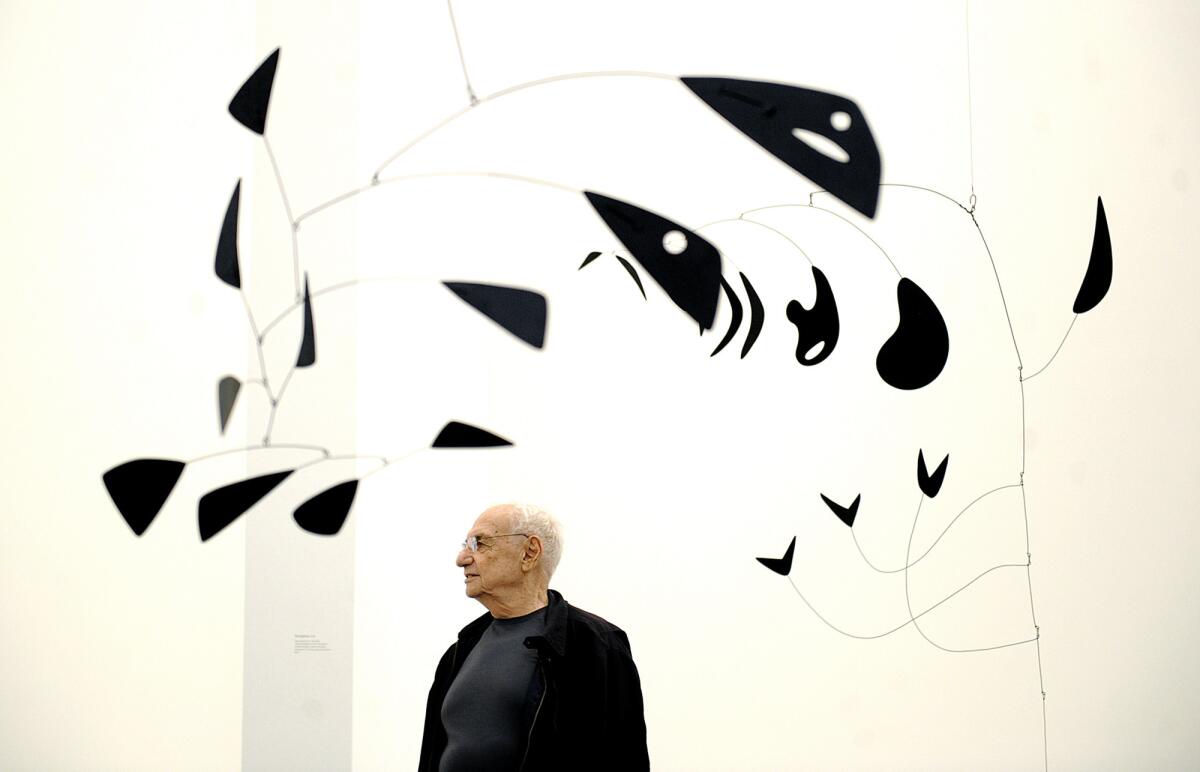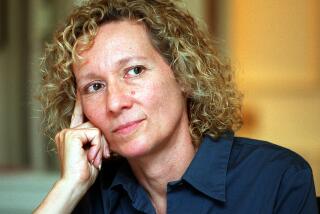Frank Gehry and Alexander Calder, a captivating union at LACMA

Dressed in corduroy pants, slip-on black shoes and a windbreaker, Frank Gehry strolled through a tiny universe of thread and painted metal mobiles. Light, curves and shadows; all clutter stripped away. The shapes floated in silence and the architect, who knows something of graceful sketches and clean designs, smiled, as if in the artist’s vision he had found a kindred whisper.
“He kind of worked intuitively,” Gehry, 84, who possesses the air of a small-town hardware salesman, said of Alexander Calder. “He probably had some idea of where he was going. But he didn’t know exactly and that process is visible, so it’s a little raw. You can feel it. He was a big kid. So am I. It’s that childlike thing that if you can maintain it through your life, it has a kind of purity to it.”
It’s an intriguing union: Gehry and Calder, who died in 1976, were influenced by and at times resisted the aesthetic trends of the last century. Both men summoned unique, unorthodox styles. So it was fitting that Gehry was asked to design the Calder exhibition at the Los Angeles County Museum of Art, which required dozens of sculptures and mobiles — some resembling fish bones, others solar systems — to breathe individually and in a wider expanse, collectively.
PHOTOS: Frank Gehry’s design for Grand Aveneue Complex
Calder’s work is at once mathematical and whimsical, playful and precise. It’s delicate as a bee’s wing and needs protection, but if too encumbered, the mobiles lose their free-spirit aplomb. Curator Stephanie Barron, who had collaborated with Gehry on five other shows, said one of the challenges was to make invisible the trappings of security. She said Gehry “solved so masterfully” the trick of giving the viewer a sense of unadorned closeness.
“His art is enormously joyful,” Barron said of Calder. The mobiles “slow you down, make you look.” She noted that in 1943, Albert Einstein went to the New York Museum of Modern Art “and spent 45 minutes looking at one Calder sculpture, watching it move and do all its permutations.” “I wish I had thought of that,” the physicist said.
Entering “Calder and Abstraction: From Avant-Garde to Iconic,” at the museum’s Resnick Pavilion, one feels as if stepping into the nave of a cathedral of soaring, curving walls and side chapels that showcase each work without diminishing its connection to the larger whole. The artifice is based on simplicity and space. Concentric circles and Gehry’s white and muted gray walls elongate the sensation and add a hint of mystery; spotlights are strategically placed and shadows linger hypnotically from one set of mobiles, echoing back on other works.
PHOTOS: Frank Gehry’s design for the Schnabel House
“The basis of everything for me is the universe,” Calder once said. “The simplest forms in the universe are the sphere and the circle. I represent them by discs, and then I vary them. My whole theory about art is the disparity that exists between form, masses and movement.”
Gehry and Barron had been unimpressed by Calder shows over the decades. “They were all terrible,” said Gehry, except the 1964 show at the Guggenheim, “which always resonated with me.... It was so beautiful.” Like Gehry’s work at LACMA, which owns about 30 Calder works including sculptures and tapestries, the Guggenheim show allowed the mobiles to float in their own colorful orbits.
“These pieces have passion,” he said, “I relate to them. Some of them make me cry.”
PHOTOS: 14 museums to visit in 2014
A creative dynamic
Gehry is a master of fluidity. One of the world’s most important architects, he conjured the Walt Disney Concert Hall in Los Angeles, the Guggenheim Museum in Bilbao, Spain, designed what is expected to become one of Berlin’s tallest buildings, and is working on skyscrapers in Santa Monica and downtown L.A. Gehry said that Calder, whose influences included Spanish surrealist Joan Miró, was “architectural in a way” and that his mobiles were “like moving paintings.”
Barron looked at Gehry and agreed. The two first worked together on a Russian avant-garde show in 1980, and Gehry’s designs of cubes and sharp angles highlighted the 2012 exhibition for sculptor Ken Price. Barron and the architect glide on each other’s sentences, one observation slipping into another, as if thumbing quickly through the pages of a book. Their sensibilities are alike but different enough to arouse creative dynamics. She is encyclopedic; he shapes mystical things from blankness. She sometimes has to remind him, a perfectionist with palpable ambition, of matters previously discussed.
A slight man with white hair, hands in pockets, Gehry, whose virtuoso renown once earned him a cartoon likeness on “The Simpsons,” said he didn’t recall discussing a cathedral metaphor for the exhibition. Yes, she said, you did. He insisted he didn’t remember. She shook her head. Minutes later, Gehry, glancing around the room, said, “I guess I did call them chapels.” His preeminent concern, however, was the imposing ceiling of the Resnick Pavilion, designed by Italian architect Renzo Piano.
PHOTOS: Best architecture moments 2013 | Christopher Hawthorne
“I was trying to, I guess, manhandle my friend Renzo’s building and to use what it has to make this work,” said Gehry. “It was a dance with him.” Gehry added that his intent was to bring the walls up to “break the insistence” in the pattern of the rectangle pavilion’s industrial top.
He walked to the end of the exhibition (open until July 27) and looked up. The light wasn’t right. The large windows and ceiling here bothered him. He seemed like a composer facing a scramble of disobedient notes. The rest had fallen so neatly into place, but this end was his nemesis, even if no one else would likely notice. He spoke of Calder and post-World War II art and architecture, of defining moments, of what endured and what was discarded.
“In the world I’ve lived in since I started work, we went through after the war a period of minimalism and found that was a dead end, of course, and then some kind of what’d they call it, postmodern stuff, then some kind of Expressionism stuff that I was doing,” he said. “I felt that Calder transcended all that.
“You can stand in front of these and feel there was a passion in it. Somebody was expressing their feelings honestly and not afraid to do it. These funny curves and things that if you draw it looks kind of silly. But through the metal and through the stuff he’s transmitted his feelings.”
‘HER’: Spike Jonze’s refreshing take on a future L.A.
He looked at Barron.
“I think shadows play an interesting part,” she said. “They help you see the piece.... You watch them dance on the walls.”
Gehry, who has many artist friends, shook his head in agreement.
“I wanted to tackle it so that there was an intimacy with the pieces so they could be seen like they’ve never been seen before,” he said. “The most important thing is to take your ego out of it. My ego’s in it, of course, but the gratification of doing this is always much better if you focus on the artist’s work and make that the main event.... I would tell my [architectural] brethren that if they let it go and flow with the work they’re looking at they come out much better.”
Shoes softly scraped. The museum was closed and Gehry had the exhibition, which took one year from design to installation to complete, pretty much to himself. He appeared in no particular hurry, walking through Calder’s fragile universe, past colors, shadows, the glint of thread. He seemed to know from where it all came.
“He didn’t worry about what people were thinking,” he said of the artist. “He expressed himself and did his work. As soon as you become self-conscious, you tighten up. If you’re worried about what someone else is going to think, you’re dead. You gotta put it out there and take what comes.”
More to Read
The biggest entertainment stories
Get our big stories about Hollywood, film, television, music, arts, culture and more right in your inbox as soon as they publish.
You may occasionally receive promotional content from the Los Angeles Times.







